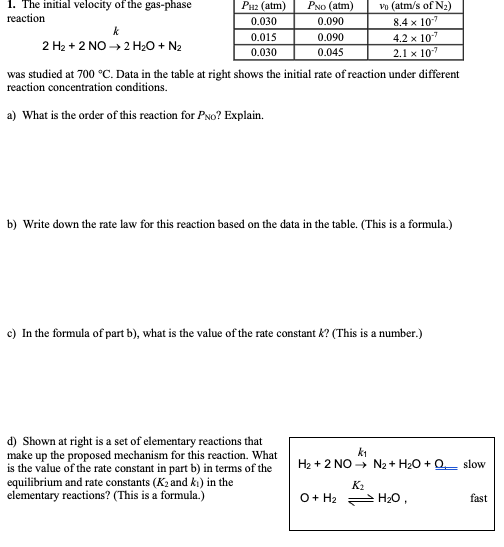1. The initial velocity of the gas-phase PNo (atm) 0.090 Рнг (atm) Vo (atm/s of N2) 8.4 x 10 4.2 x 10" reaction 0.030 k 0.015 0.090 2 H2 + 2 NO → 2 H20 + N2 0.030 0.045 2.1 x 107 was studied at 700 °C. Data in the table at right shows the initial rate of reaction under different reaction concentration conditions. a) What is the order of this reaction for PNo? Explain. b) Write down the rate law for this reaction based on the data in the table. (This is a formula.) c) In the formula of part b), what is the value of the rate constant k? (This is a number.)
1. The initial velocity of the gas-phase PNo (atm) 0.090 Рнг (atm) Vo (atm/s of N2) 8.4 x 10 4.2 x 10" reaction 0.030 k 0.015 0.090 2 H2 + 2 NO → 2 H20 + N2 0.030 0.045 2.1 x 107 was studied at 700 °C. Data in the table at right shows the initial rate of reaction under different reaction concentration conditions. a) What is the order of this reaction for PNo? Explain. b) Write down the rate law for this reaction based on the data in the table. (This is a formula.) c) In the formula of part b), what is the value of the rate constant k? (This is a number.)
Chemistry & Chemical Reactivity
9th Edition
ISBN:9781133949640
Author:John C. Kotz, Paul M. Treichel, John Townsend, David Treichel
Publisher:John C. Kotz, Paul M. Treichel, John Townsend, David Treichel
Chapter14: Chemical Kinetics: The Rates Of Chemical Reactions
Section: Chapter Questions
Problem 84IL
Related questions
Question
Please solve this

Transcribed Image Text:1. The initial velocity of the gas-phase
PNo (atm)
0.090
Рнг (atm)
Vo (atm/s of N2)
8.4 x 10
4.2 x 10"
reaction
0.030
k
0.015
0.090
2 H2 + 2 NO → 2 H20 + N2
0.030
0.045
2.1 x 107
was studied at 700 °C. Data in the table at right shows the initial rate of reaction under different
reaction concentration conditions.
a) What is the order of this reaction for PNo? Explain.
b) Write down the rate law for this reaction based on the data in the table. (This is a formula.)
c) In the formula of part b), what is the value of the rate constant k? (This is a number.)
d) Shown at right is a set of elementary reactions that
make up the proposed mechanism for this reaction. What
is the value of the rate constant in part b) in terms of the
equilibrium and rate constants (K2 and ki) in the
elementary reactions? (This is a formula.)
ki
H2 + 2 NO - N2 + H20 + Q slow
K2
O+ H2 H2O,
fast
Expert Solution
This question has been solved!
Explore an expertly crafted, step-by-step solution for a thorough understanding of key concepts.
Step by step
Solved in 2 steps with 2 images

Knowledge Booster
Learn more about
Need a deep-dive on the concept behind this application? Look no further. Learn more about this topic, chemistry and related others by exploring similar questions and additional content below.Recommended textbooks for you

Chemistry & Chemical Reactivity
Chemistry
ISBN:
9781133949640
Author:
John C. Kotz, Paul M. Treichel, John Townsend, David Treichel
Publisher:
Cengage Learning

Chemistry & Chemical Reactivity
Chemistry
ISBN:
9781337399074
Author:
John C. Kotz, Paul M. Treichel, John Townsend, David Treichel
Publisher:
Cengage Learning

Chemistry for Engineering Students
Chemistry
ISBN:
9781337398909
Author:
Lawrence S. Brown, Tom Holme
Publisher:
Cengage Learning

Chemistry & Chemical Reactivity
Chemistry
ISBN:
9781133949640
Author:
John C. Kotz, Paul M. Treichel, John Townsend, David Treichel
Publisher:
Cengage Learning

Chemistry & Chemical Reactivity
Chemistry
ISBN:
9781337399074
Author:
John C. Kotz, Paul M. Treichel, John Townsend, David Treichel
Publisher:
Cengage Learning

Chemistry for Engineering Students
Chemistry
ISBN:
9781337398909
Author:
Lawrence S. Brown, Tom Holme
Publisher:
Cengage Learning



Chemistry: The Molecular Science
Chemistry
ISBN:
9781285199047
Author:
John W. Moore, Conrad L. Stanitski
Publisher:
Cengage Learning